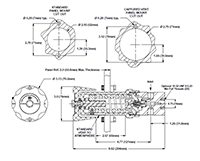| Items |

BP66-1A11C4Q154
BP-66 0 to 10,000 Pounds per Square Inch Gauge (psig) Control Range and Polyimide Actuator Material High Back Pressure Regulator
|

BP66-1A11CEO151
BP-66 0 to 6000 Pounds per Square Inch Gauge (psig) Control Range and Polyimide Actuator Material High Back Pressure Regulator
|

BP66-1A11QEN161
BP-66 0 to 4000 Pounds per Square Inch Gauge (psig) Control Range and Polyetheretherketone™ (PEEK™) Actuator Material High Back Pressure Regulator
|

BP66-1A11QJN161
BP-66 0 to 4000 Pounds per Square Inch Gauge (psig) Control Range and Polyetheretherketone™ (PEEK™) Actuator Material High Back Pressure Regulator
|

BP66-1A15QEL151
BP-66 0 to 2000 Pounds per Square Inch Gauge (psig) Control Range and Polyetheretherketone™ (PEEK™) Actuator Material High Back Pressure Regulator
|
|
Description
|
N/A
The BP-66 Series is the counterpart of the PR-57 pressure reducing series for systems that are higher in pressure and low to moderate flows. This regulator has piston sensing to provide relief at high pressures. The Polyimide/stainless seat assembly provides good shutoff in most applications. For economy purposes the cap assembly and knob are of aluminum construction as in the PR-57 companion unit. Good sensitivity and a selection of control ranges make this regulator an excellent selection in many research and pilot plant facilities.
|
|
Brands
|
N/A
GO Regulator, Inc.
|
|
Operating Temperature
|
N/A
-40 to +350 ºF-40 to +177 ºC
|
|
Inlet and Outlet Connections
|
N/A
1/4 in. Female National Pipe Tapered (FNPT) (Standard) Aerospace Standard (AS) 10050-4, Society of Automotive Engineers (SAE) J514, Military Standard (MS) 33649, or 3/8" Female National Pipe Tapered (FNPT) (Optional)
|
|
Body Material
|
N/A
316L Stainless Steel
|
|
Port Configuration
|
N/A
Standard
|
|
Process Port Size
|
N/A
1/4 in
|
|
Process Port Types
|
N/A
Female National Pipe Tapered (FNPT)
|
|
Gauge Port Size
|
N/A
1/4 in
|
|
Gauge Port Types
|
N/A
Female National Pipe Tapered (FNPT)
|
|
Cavity Finish
|
N/A
< 25 Ra
|
N/A
< 25 Ra
|
N/A
< 25 Ra
|
N/A
< 25 Ra
|
N/A
25 Ra with 10-32 Mounting Holes
|
|
Actuator Material
|
N/A
Polyimide
|
N/A
Polyimide
|
N/A
Polyetheretherketone (PEEK™)
|
N/A
Polyetheretherketone (PEEK™)
|
N/A
Polyetheretherketone (PEEK™)
|
|
Flow Coefficient (Cv)
|
N/A
0.12
|
N/A
0.04
|
N/A
0.04
|
N/A
0.01
|
N/A
0.04
|
|
Control Range
|
N/A
0 to 10,000 psig
|
N/A
0 to 6000 psig
|
N/A
0 to 4000 psig
|
N/A
0 to 4000 psig
|
N/A
0 to 2000 psig
|
|
Piston Type
|
N/A
Standard
|
|
Piston Material
|
N/A
Stainless Steel with Standard Fluorocarbon (FKM) Cavity O-Ring
|
N/A
Stainless Steel with Standard Fluorocarbon (FKM) Cavity O-Ring
|
N/A
Stainless Steel with optional Polytetrafluoroethylene (PTFE) Cavity O-Ring
|
N/A
Stainless Steel with optional Polytetrafluoroethylene (PTFE) Cavity O-Ring
|
N/A
Stainless Steel with Standard Fluorocarbon (FKM) Cavity O-Ring
|
|
Cap Assembly
|
N/A
Panel Mount, Aluminum
|
N/A
Standard, Aluminum
|
N/A
Standard, Aluminum
|
N/A
Standard, Aluminum
|
N/A
Standard, Aluminum
|
|
Weight
|
N/A
4.4 lb2.0 kg
|
|
Typical Applications
|
N/A
- Pilot plants
- Research labs
|
|
Features and Benefits
|
N/A
- Spring-loaded piston sensor
- Gas and liquid service
- Fluorocarbon (FKM) seals (other elastomers optional)
|
|
Options
|
N/A
- Panel mounting
- Monel® and titanium body construction
- Cv of 0.01 or 0.12
- AN 10050-4, SAE J514, MS 33649 or 3/8" FNPT connections
|
|
Note
|
N/A
The choices above represent an abbreviated list of the more commonly ordered options.
|



